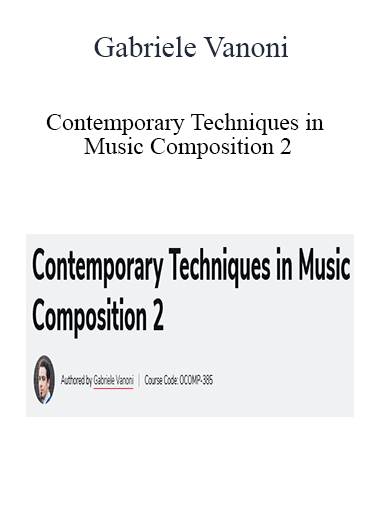Gabriele Vanoni – Contemporary Techniques in Music Composition 2
$1,250.00 Original price was: $1,250.00.$250.00Current price is: $250.00.
Digital Download: You will receive a download link via your order email after successful payment.
Over the course of the twentieth and twenty-first centuries, music has experienced an unprecedented acceleration in its language and aesthetics. Arguably, the past 50 years of compositional development saw more innovation than the previous four centuries.
Contemporary Techniques in Music Composition 2
Over the course of the twentieth and twenty-first centuries, music has experienced an unprecedented acceleration in its language and aesthetics. Arguably, the past 50 years of compositional development saw more innovation than the previous four centuries. Contemporary art music played a key role in this musical revolution, being cutting edge in several aspects, including the expansion of instrumental techniques, the creation of new compositional systems, and the introduction of computer technology. The intellectual and musical development of this period is undeniable and the music created by these composers was unprecedented.
Music for films, commercials, and video games are now filled with these effects, granting composers of every kind of media a larger palette to express their ideas. Any music student interested in composing in new forms and genres will find the achievements of these artists worthy of study.
Upon completion of this music composition course, you will have a solid knowledge of modern instrumental writing and competence using twentieth century techniques in composition. In addition, you will gain enhanced listening skills to identify and appreciate new musical styles, and be capable of implementing these skills in your writing, enriching your capacity to express yourself in this intellectually stimulating musical idiom. The lesson material is presented through listening exercises, analysis, and weekly composition projects.
Because of the complexity and fragmentation of the curriculum, this course is organized in units. You will start where you left off in OCOMP-285: Contemporary Techniques in Music Composition 1 by expanding your knowledge of extended techniques for traditional instruments and voice. The second unit of this music composition course will cover new compositional systems and styles from the early 1920s through the modern day, such as serialism and minimalism. The third unit will focus on the relationship between tradition and tonal music, focusing on those composers with an interesting relationship to the past, such as the post-modernists. Finally, there will be a set of lessons on technology, allowing you to get a glimpse of computer-assisted composition with the help of a software tool developed especially for this course.
You will become familiar with the compositional innovations of Igor Stravinsky, Arnold Schoenberg, Anton Webern, Alban Berg, Gyorgy Ligeti, Pierre Boulez, Karlheinz Stockhausen, George Crumb, Luciano Berio, Steve Reich, Terry Riley, Helmut Lachenmann, Mario Davidovsky, and Sofia Gubaidulina.
By the end of this course, you will be able to:
- Compose using tonal and non-tonal material, adding more extended techniques to your compositional palette
- Experiment with microtonality, scales and chords beyond the equal temperament, and notate and play them
- Discover how writing for voice has evolved in the last few decades and experiment with some techniques using your own voice
- Acquire the main techniques of serial music and compose a serial piece
- Compose and demonstrate the key techniques of process-based music, such as minimalism
- Experiment with meter and rhythm, including metric modulation
- Implement music quotations in your own music and explain postmodern music and aesthetics
- Write a tonal piece informed by the most recent uses of tonality
- Compose with “pure sounds” and use technology to create your first collage piece
- Compose your first computer-assisted composition and learn about technology-based techniques developed by movements such as Spectralism and Musique Concrète using ad hoc software
- Be capable of identifying several contemporary musical styles just by listening
- Create a final piece of music that reflects your personal and unique take on the concepts covered in the course
Syllabus
Lesson 1: Extended Techniques for Strings, Winds, and More
Lesson 2: Microtonality and Tunings
Lesson 3: Writing for Voice
Lesson 4: Serial Music
Lesson 5: Process Music/Textures and Soundscapes
Lesson 6: Harmonic Movement
Lesson 7: Beyond Modernism: Later Developments on Rhythm
Lesson 8: Rehashing the Past: Post-Modernism
Lesson 9: New Tonality
.rTable { display: table; width: 100%;}
.rTableRow { display: table-row; }
.rTableHeading { background-color: #ddd; display: table-header-group; }
.rTableCell, .rTableHead { display: table-cell; padding: 3px 10px; border: 1px solid #999999; }
.rTableHeading { display: table-header-group; background-color: #ddd; font-weight: bold; }
.rTableFoot { display: table-footer-group; font-weight: bold; background-color: #ddd; }
.rTableBody { display: table-row-group; }
.rTable { display: table; width: 100%;}
.rTableRow { display: table-row; }
.rTableHeading { background-color: #ddd; display: table-header-group; }
.rTableCell, .rTableHead { display: table-cell; padding: 3px 10px; border: 1px solid #999999; }
.rTableHeading { display: table-header-group; background-color: #ddd; font-weight: bold; }
.rTableFoot { display: table-footer-group; font-weight: bold; background-color: #ddd; }
.rTableBody { display: table-row-group; }
Get Download Gabriele Vanoni – Contemporary Techniques in Music Composition 2 at imcourse.biz today!
Delivery Method
– After your purchase, you’ll see a View your orders link which goes to the Downloads page. Here, you can download all the files associated with your order.
– Downloads are available once your payment is confirmed, we’ll also send you a download notification email separate from any transaction notification emails you receive from imcourse.biz.
– Since it is a digital copy, our suggestion is to download and save it to your hard drive. In case the link is broken for any reason, please contact us and we will resend the new download link.
– If you cannot find the download link, please don’t worry about that. We will update and notify you as soon as possible at 8:00 AM – 8:00 PM (UTC+8).
Thank You For Shopping With Us!
Be the first to review “Gabriele Vanoni – Contemporary Techniques in Music Composition 2” Cancel reply
Login





5 reviews for Gabriele Vanoni – Contemporary Techniques in Music Composition 2
There are no reviews yet.